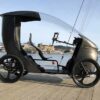Cycling duralumin frames? Been there? Got any? Will be?
12.08.2021
3443
Since its introduction in the 1930s, when lightweight and strong elements of duralumin frames were fastened together with locks or rivets, at last century’s end, bicycle frames began to use glue and bond-lock connections. Modern duralumin analogs, such as the 7xxx series of alloys, have already surpassed duralumin strength and are also used in the construction of bicycle frames.
Robust but lightweight metals have been attractive to makers since the first bicycles. This industry went from a wide variety of steel to aluminum alloys and carbon composites. The 1930s were a watershed year for the aluminum Industry and the cycling industry’s place in it. In 1893, the St. Louis Refrigerator and Wooden Gutter has produced its first aluminum novelty – LuMiNum. There were other manufacturers who pioneered the use of aluminum in bicycle manufacturing. Yet, early pure aluminum simply didn’t have the tensile strength and resiliency of steel. The popularity of duralumin has been successful in revolving the way that bicycles and components are produced, significantly impacting their product design and consumer properties.
Also referred to as duraluminum or dural is the name for one of lightest and toughest aluminum-copper series alloys [1]. One of the most famous are the alloys 2014 and 2024, both of which are used to manufacture aircraft fuselages. Duralumin was obtained for the first time by German metallurgist Alfred Wilm in 1903 and started to be employed as a commercial alloy in 1909. The strength of this alloy was known for its high values – up to 370 MPa (strength of pure aluminum is 70-80 MPa), that made this alloy demanded in many industries. It was initially used for the rigid frames of airships, and its heat treatment methods and composition were a mystery. Duralumin was used in the manufacture of bicycle frameworks from the 1930s through the 1990s.
Among the most well-known is Pierre Caminade, considered to be the French bicycle manufacturer from 1910-1950 [3]. He developed a facilitated design in the mid-1930s, sold under the trade name Caminargents, using duralumin octagonal tubes in the frame, that were clamped round the pipes and screwed down to form connections. There were only a comparatively small number of duralumin frame bicycles produced, for professional racers and prosperous amateurs.
Between the 1930s and 1950s, French and Italian producers made common use of aluminum alloys, incorporating duralumin, to make bicycle frames [5]. Many of these companies were specialized in custom manufacturing of lightweight bicycles, manufacturing only a couple of dozens or a hundred of these vehicles per year. The duralumin frame of the Mercier Meca bicycle of the 1940s / 50s, for instance, is a true work of art in engineering. The tubes were joined by lugs and internal expanding wedge-locks of the original design, which were mounted with a special tool.
Nicolas Barra was among the veritable visionaries in the lightweight bicycle industry.
The first welded aluminum bicycle took place in the 1936 Grand Prix. Then he designed a number of fantastic duralumin frames named Barralumin. These were a real technological breakthrough compared to the then used bolted or riveted frameworks made of the very same alloy. There were several frames that were used in the Tour de France, the most well-known of which was the Vietto. The welding of such a frame demanded a great deal of skill and the technique that Nicolas Barra devised himself.
In the postwar year of 1948, one of the most exciting was the Dujee Bicycle with duralumin frame, devised by the Mitsubishi Heavy Industries engineers [8]. The innovative bicycle design was distinguished by its frame, whose elements are fastened together with many rivets similar to the planes that the Japanese had made earlier.
When it debuted in the fall of 1979, the Vitus 979 Duralinox French frame unveiled a host of inventions that in so many ways shaped an industry decade, being one of the best-selling and most successful commercial race cycles ever made [4]. This was the easiest bike of its time, weighting about 30% less than the top of the line steel frame Reynolds or Columbus. The frame and yoke of the Vitus 979 weighed only 1.8 kg. In practical terms, the total lack of colorized finishes made the duralumin frame cheaper to manufacture and maintain.
Looking at the 1982 Peugeot bicycle catalog, the premium road racing bike PX10-DU.J was composed of a Vitus 979 duralumin frame with the highest standard French components of the time. In the catalog the special weight of this model was 8.6 kg [9].
But the copper grade of the aluminium alloy demanded compromises. By providing a substantial improvement in the strength of the alloy, the copper is also contributing to rust, as the produced grade will oxidize faster than a purer grades as it reacts with the surrounding environment in an electric-chemical manner. This is mainly why the duralumin we all recognize is no more used in the construction of bicycle frames [2].
Alloys from the 7xxx series of aluminum have been used in the aerospace and aircraft industries in the past years. For instance, alloy 7050 has high corrosion and strength retention over a wide area, making it more stable against breakage than the other alloys. This is commonly used in fender and body cladding, particularly in warplanes. Aluminium alloy 6061 is commonly used in the design of light airplanes, especially homemade airplanes. With nearly the strength of steel, which is achieved due to the high zinc content, alloy 7075 has an excellent resistance to fatigue and high corrosion resistance [10]. Newly developed aluminum-lithium alloys may become an alternate to the currently used because of their low density, excellent strength properties and high fatigue resistance.
The Duratec frames are currently being made in the Czech Republic from a special material – the super-light and durable aluminum alloy 7020. This material is the modern counterpart of duralumin. Originally developed for the aerospace industry due to its durability and low weight, such an alloy is the ideal bicycle frame materials by most of its endurance features, providing an extraordinary riding experience, flexible, rigid and comfortable [6].
AMSpec, a Taiwanese company, employs SPD (strong plastic deformation) process to manufacture bicycle frames tubes. The bicycle frame tubes of 7000 series alloy that they offer can achieve a ultimate tensile strength of over 600 MPa [7]. Therefore, modern aluminum aluminum grades are now overtaking the duralumin frame strengths that were very popular in the previous century.
The electric bike frames created by the Avial Bikes startup team are made from aircraft alloys 6061 and 7075. There is no welding involved in the manufacturing of the bicycle frames, and all elements of the frame are attached to each other by means of adhesive and rivets. This production process also makes for a strong, light and durable supporting structure.
Look in detail:
[1] Duralumin – Bicycling applications – https://en.wikipedia.org/wiki/Duralumin
[2] Duralumin History & Use in Bicycle Building – https://www.ebykr.com/duralumin-history-and-use-in-bicycle-building/
[3] Bicycle – Duralumin – https://collections.museumsvictoria.com.au/items/395713
[4] Light & Legendary: Vitus 979 – https://on-the-drops.blogspot.com/2016/12/the-peugeot-px-10du-vitus-979.html
[5] Meca Dural Duralumin Bicycle – https://restoringvintagebicycles.com/2016/01/09/meca-dural-duralumin-frame/
[6] Duratec Frames – https://www.bicycles-by-design.co.uk/bicycles/duratec/
[7] Bicycle Frame – https://www.amspec-inc.com/Bicycle-Frame-Tubes.html
[8] Mitsubishi Dujee Bicycle – https://www.polyplastics.com/en/pavilion/bicycle/1948.html
[9] Peugeot in 1982 – http://cyclespeugeot.web.fc2.com/reminiscence/peugeot82.htm
[10] Aluminum alloys for aerospace – https://www.aerospacemanufacturinganddesign.com/article/aluminum-alloys-for-aerospace/














